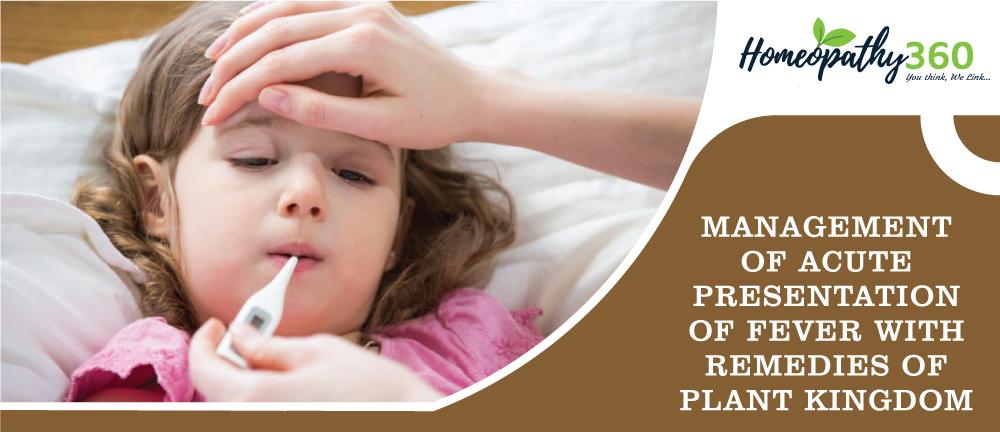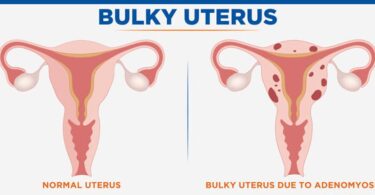
Abstract
“Homoeopathy is very slow to act, so cannot be used in acute cases, especially in fever.” This statement is frequently heard from patients and doctors alike for homoeopathy! However, this is a sheer myth which needs to be busted through correct application of homoeopathic philosophy and homoeopathic materia medica. A homoeopath should have thorough understanding of pathology of fevers as well as pathogenesis of homoeopathic drugs to practically succeed in bringing the fever down in shortest, safest and gentle way.
This article peeks into the mega collection of homoeopathic therapeutics in fever through the window of plant kingdom.
Keywords
Fever, typhus, influenza, intermittent, remittent fever, homeopathy, plant remedies, compositae, ranunculaceae, solanaceae, loganiaceae.
Introduction
Fever often causes distress to the homoeopath as it is a challenging symptom to treat in day to day practise. Dr Morrison has written in his book, Desktop Companion to Physical Pathology1, “one of our biggest challenges is confronting the anxieties and habits of the patient or parents who may feel that every fever requires, at the minimum, some antipyretic. The homoeopath sometimes surrendering to this pressure and anxiety, prescribes remedies which may abort some fevers at that time, but they may thus prolong the illness or obscure a better remedy later in the course of the illness.”
All said and done, the big question remains, “how to manage a case of acute fever?” Among students and new practitioners, there is apprehension as how to approach a case of fever, what is to be noted in symptomatology to hit the correct prescription, how to take the case and how to manage fever after the first prescription.
How to proceed in such cases of fever?
- The first thing to look out for in any disease is the condition of the sick in suffering. Similarly, in fevers, one has to mark out the usual symptoms of disease and the individual symptoms of the patient in that disease, to find out what does the patient feels before, during and after the paroxysm. Was there any exciting factor such as emotions or exposure to a different climate that triggered the immune response involving fever? All these along with the general symptoms of patient during fever can fairly point in direction of small number of remedies which can be compared with the help of materia medica and repertory to get the simillimum of the case.
This is what Dr Hahnemann instructed in aphorism 3 of ‘Organon of Medicine’ that the physician should essentially have knowledge of disease in every case of sickness and should have a sound knowledge of the curative power of his drugs hence understanding the central pathological effect of drugs and the symptoms produced by them is necessary.
In an acute case of fever the physician should be quick and vigilant of patient’s look, his decubitus and his state of vitality. He should note down the key points like:
- Pattern of fever.
- System involvement through physical examination.
- Concomitants and modalities.
- Patient’s expressions, alertness, eye contact while talking, clinging to attendant, suspicious or trustful or submissive, whether disorganised or structured, wanting attention, or being irritated, shy, embarrassed or uncomfortable.
- Vital parameters.
- For paediatric cases, we need to observe the child keenly, especially their reactions and/or behaviour during fever, as often the information given by the parents is full of their own anxieties and worries, rather than objective.
- A good history often unveils the roadblocks in a case. Sometimes, the fever is an acute exacerbation of an underlying long standing chronic illness. In the case of a recurrence, one can give an inter-current remedy to remove the block that might be hindering the cure.
- While evaluating the general symptoms, one should not miss peculiar and characteristic symptoms of the case, which are decisive in selection of remedy on the homoeopathic principle of individualisation.2
Plant remedies for management of fever
Homoeopathic therapeutics for fever is vast. To differentiate the large number of remedies, one has to level them up on a single platform. The plant temperament is cheerful, amorous, and sensitive but under acute stress they react with acute disorders, emotional crisis, and alternating mental and physical symptoms, which one often encounters in acute cases of fever. Thus, these remedies are suitable for acute crisis and as inter-current remedies for treatment of disruptions due to strong exciting causes.This become more apparent as one studies the differentiation of individual plant families in fever.
- COMPOSITAE FAMILY: Of significant value in fevers. Special affinity for blood and capillaries. Predominantly chilly. Affections from motion, damp cloudy weather, cold air, injury, drinking, evening, night and suppressed discharges.
- Abrotanum: High fever of rheumatic origin. Hectic fever, with chilliness, very weakening.3
- Arnica montana: Typhus, putrid breath and stool. Nocturnal acid sweat. Chilliness, internally, with external heat. Head alone, or face alone, hot, rest of body cool. Redness of one cheek. <evening, and sometimes with a sensation as if one were sprinkled with cold water. Much thirst, even before the shivering.4
- Chamomilla: Chilliness and coldness of the forepart of the body, while the back part is hot. General heat, < evening, or at night in bed, with anxiety, thirst, redness of the cheeks, hot perspiration of the head, at the forehead, and the scalp; and sometimes, chiefly on uncovering the body, mixed with shivering or shuddering.4
- Cina maritima: Quotidian or tertian fevers, with bulimia, nausea, tongue clean, diarrhoea. Pupils dilated, and emaciation. Shivering in the evening. Strong febrile heat, with delirium, tossing, and agitation. Chilliness, with shaking or trembling, ascending from the upper part of the body to the head. Fever due to worm affections.4
- Eupatorium perforatum: “I ache horribly” is the keynote often encountered while prescribing this remedy. Fever commences in morning; with painfulness, trembling, weakness, and soreness; but little or no perspiration. Indicated for influenza, intermittent, relapsing, remittent types of fever. Headache, backache, and thirst during the chill.4
- RANUNCULACEAE FAMILY: Generally affects the nervous system, and mucous membranes. Predominantly chilly; warm room and warmth being the prime causation.
- Aconitum napellus: First remedy to think of when a patient is coming with a flu-like illness. Taken within the first 24 hours of symptoms suddenly appearing. Asthenic fever, hyperaemia, and congestion and chill preceding inflammatory fever. Frequent chilliness in fever often calls for Aconitum napellus. Anxiety, mental anguish, and restlessness from the violent circulatory storm; dry skin, violent thirst, full bounding frequent pulse; fever often terminates with a critical sweat. 3
- Helleborus niger: In this remedy, the chill spreads from the arms. Coldness of the whole body, and esp. of the extremities. After lying down in bed, the heat comes on immediately, generally accompanied by perspiration. Pulse, small, slow, and almost imperceptible. Often of use in typhoid fever.4
- Clematis erecta: Quartan fever, characterized by shuddering, followed by sweat. Sensitiveness of the skin, which the patient cannot bear to be uncovered. Pulse is accelerated.
- Pulsatilla nigricans: Chilliness even in warm room, without thirst, principally in evening or afternoon, with paleness of face, vertigo, and dizziness, pain and heaviness in head; anxiety and oppression of chest, vomiting of mucus. Heat of face or of one hand, with coldness of the other. In puerperal and intermittent type of fever.
- Staphysagria: Chill ascends from back over head. Ravenous hunger, before and after the paroxysms of intermittent fever. Tertian fever (with symptoms of scurvy), bitter taste, bleeding gums, anorexia, and constipation. Pulse very fast but small and trembling. Dentition fever.
- SOLANACEAE FAMILY: Majorly affect the joints, muscles along with the mucus membranes and cardiovascular system. Tubercular diathesis and predominantly chilly. Affections from cold winds, heat of sun and suppressions.
- Belladonna: “Feel the heat radiating from me” is the keynote, often found in Belladona fever.Eyes red and glistening; skin is hot and burning; followed by a profuse sweat which brings no relief. General dry heat with chills, little or no thirst, in fact, the patient may have dread of water, cool extremities and throbbing headache.3
- Capsicum annum: Shivering and coldness over the whole bodycommencing at the back and between shoulders, with ill-humor increasing with the cold. Anxiety, dizziness and dullness of the head. Thirst, burning heat, and affections of the mucous membranes. Pulse irregular, intermitting.
- Dulcamara: Chilliness, mostly in back, towards evening, with thirst.Icy coldness, with pains. Dry heat and burning of skin. Useful in hectic fever, typhoid, allergic (hay-fever), influenza; inflammatory fevers.
- Hyoscyamus niger: Fever, with fits of epilepsy, great weakness, flames before the eyes, and congestion in the head, quartan or quotidian type. Pulse quick (full hard), with swelling of the veins (arteries). Universal coldness over the whole body, with heat of face, ascending from the feet.4
- Stramonium:Intermittent fever. Chill over whole body without thirst, followed by heat and anguish; sleep during hot stage, and violent thirst after waking up, which causes a stinging in throat, until he drinks something. Frequent profuse sweat. Retention of urine in any fever. Fever after fright, shock, childbirth, suppressed emotions or infections.4
- LOGANIACEAE FAMILY: Nervous system, gastro-intestinal system, cardiovascular affections. Predominantly chilly. Ailments from grief, sudden joy, coffee, mental excitement, morning.
- Ignatia amara: Fever, with headache, and pain in the pit of the stomach, great fatigue, paleness of face, or paleness and redness alternately, lips dry and cracked, nettle-rash, tongue white, profound sleep with snoring. Intermittent fever; chill with thirst, followed by heat (without thirst). Pulse hard, full and frequent, or very variable.
- Gelsemium sempervirens: This remedy suits dull, stupid, apathetic conditions. The patient is dizzy and drowsy, the chill is partial; there is a full flowing pulse with an element of weakness in it. It corresponds especially to remittent types of fever and to fevers brought on by warm, relaxing weather. The fever is accompanied by languor, muscular weakness, desire for absolute rest and thirstlessness.3
- Nux vomica: The Nux vomica fever is characterized by great heat; the whole body is burning hot, the face is especially red and hot, yet the patient feels chilly when uncovering.3“Every nerve is frayed” is often what a Nux vomica patient is complaining during fever.
- Spigelia anthelmia: The chill extends from the chest. Heat in face and on hands, with chill in back. Thirst for beer during the heat (with flushes of heat at night). At night, putrid perspiration with heat at the same time. Cold, clammy perspiration.
Conclusion
If the first prescription is well chosen, the patient feels better within short duration of taking the medicine, whether the fever starts declining or not. His discomfort gets slowly faded away with only fever remaining to go. A short rise in fever with comparative relief felt by the patient is usually a part of homoeopathic aggravation, but if fever rises along with patient’s discomfort and suffering, then an increase in temperature indicates a further spread of infection. Correspondingly, a decrease in temperature shows that the infection is fading away. As a general practise, giving antipyretics, brings down the temperature suddenly without halting the infection. In the absence of fever, there is no way to find out the extent and progress of infection causing fever.
Homoeopathic fever management involves, elevating the patient’s vital force to fight against the infection or the pyrogens causing fever. Once that is done, the discomfort goes away and the so does the fever. As the vital force gets restored, there isn’t any trace of residual weakness persisting after the fever. Thus, successful implementation of the “nature’s law of cure” for such cases requires mastering the identification of the clinical condition, the state of the patient in sickness, and the most similar reflection of his suffering in materia medica of well proven drugs.
References
- Morrison R, Desktop Companion to Physical Pathology. Hahnemann Clinic Pub. 1998
- Dhanipkar GV., M.D., Conquering Fevers with Homoeopathy Clinical Experiences. Homoeopathic Medical Publishers. 2017
- Dewey WA., Practical Homeopathic Therapeutics. New Delhi: B Jain Publishers; 2009
- Clarke J H. Dictionary of Practical Materia Medica. New Delhi: B Jain Publishers; 1991
About Author:
Dr Jyoti Chhikara, MD (Part II), Department of Materia Medica, Bakson’s Homoeopathic Medical College and Hospital, Greater Noida.
Dr Vasundhara Mehrotra, MD (Part II), Department of Materia Medica, Bakson’s Homoeopathic Medical College and Hospital, Greater Noida.





